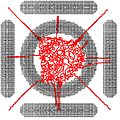Polywell
Polywell is a type of nuclear fusion reactor that uses an electric field to heat ions to fusion conditions. It is a variant of the Fusor, a device that creates fusion by using an electric field to heat ions to fusion conditions. The name "Polywell" is a combination of "polyhedron" and "potential well".
History
The concept of Polywell was developed by physicist Robert Bussard, who believed that it could provide a practical solution to energy production through nuclear fusion. Bussard's work on Polywell was initially funded by the U.S. Navy, but funding was discontinued in 2007. Despite this, research and development on Polywell continues through private companies such as Tri Alpha Energy and EMC2 Fusion.
Design and Operation
The Polywell reactor design consists of a polyhedral magnetic field that contains a cloud of ions. The ions are accelerated towards the center of the reactor by an electric field, where they collide and undergo fusion. The fusion reactions produce high-energy neutrons and helium, which can be used to generate electricity.
The key advantage of the Polywell design is its potential for net energy gain. Unlike other fusion reactor designs, the Polywell does not require a large amount of energy to maintain the fusion reaction. This makes it a promising candidate for a practical fusion power plant.
Challenges and Criticisms
Despite its potential, the Polywell design faces several challenges. One of the main criticisms is the difficulty in maintaining a stable plasma cloud within the reactor. The plasma tends to spread out and lose energy, which reduces the efficiency of the fusion reactions.
Another challenge is the production of high-energy neutrons, which can cause damage to the reactor walls and produce radioactive waste. However, proponents of the Polywell design argue that these issues can be mitigated through proper reactor design and materials.
Future Prospects
The future of Polywell as a practical fusion power source depends on overcoming the technical challenges and demonstrating a net energy gain. If successful, it could provide a clean, abundant source of energy and help to mitigate the effects of climate change.
Transform your life with W8MD's budget GLP-1 injections from $125.
W8MD offers a medical weight loss program to lose weight in Philadelphia. Our physician-supervised medical weight loss provides:
- Most insurances accepted or discounted self-pay rates. We will obtain insurance prior authorizations if needed.
- Generic GLP1 weight loss injections from $125 for the starting dose.
- Also offer prescription weight loss medications including Phentermine, Qsymia, Diethylpropion, Contrave etc.
NYC weight loss doctor appointments
Start your NYC weight loss journey today at our NYC medical weight loss and Philadelphia medical weight loss clinics.
- Call 718-946-5500 to lose weight in NYC or for medical weight loss in Philadelphia 215-676-2334.
- Tags:NYC medical weight loss, Philadelphia lose weight Zepbound NYC, Budget GLP1 weight loss injections, Wegovy Philadelphia, Wegovy NYC, Philadelphia medical weight loss, Brookly weight loss and Wegovy NYC
|
WikiMD's Wellness Encyclopedia |
| Let Food Be Thy Medicine Medicine Thy Food - Hippocrates |
Medical Disclaimer: WikiMD is not a substitute for professional medical advice. The information on WikiMD is provided as an information resource only, may be incorrect, outdated or misleading, and is not to be used or relied on for any diagnostic or treatment purposes. Please consult your health care provider before making any healthcare decisions or for guidance about a specific medical condition. WikiMD expressly disclaims responsibility, and shall have no liability, for any damages, loss, injury, or liability whatsoever suffered as a result of your reliance on the information contained in this site. By visiting this site you agree to the foregoing terms and conditions, which may from time to time be changed or supplemented by WikiMD. If you do not agree to the foregoing terms and conditions, you should not enter or use this site. See full disclaimer.
Credits:Most images are courtesy of Wikimedia commons, and templates, categories Wikipedia, licensed under CC BY SA or similar.
Contributors: Prab R. Tumpati, MD









